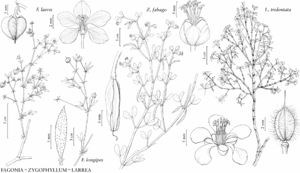Difference between revisions of "Fagonia longipes"
Proc. Biol. Soc. Wash. 24: 250. 1911.
FNA>Volume Importer |
imported>Volume Importer |
||
| Line 55: | Line 55: | ||
|publication year=1911 | |publication year=1911 | ||
|special status=Illustrated | |special status=Illustrated | ||
| − | |source xml=https:// | + | |source xml=https://bibilujan@bitbucket.org/aafc-mbb/fna-data-curation.git/src/bb6b7e3a7de7d3b7888a1ad48c7fd8f5c722d8d6/coarse_grained_fna_xml/V12/V12_318.xml |
|genus=Fagonia | |genus=Fagonia | ||
|species=Fagonia longipes | |species=Fagonia longipes | ||
Revision as of 20:08, 27 May 2020
Subshrubs or shrubs, (0.1–)0.3–0.5 m, less than 1 m diam. Stems erect to spreading, intricately branched, light green, very slender, sparsely to densely minutely stipitate-glandular, glands clear or yellow, to 0.1 mm diam.; older stems and branches becoming glabrate, scaberulous. Leaves 3-foliolate; stipules curved, slightly reflexed to spreading, subulate, 1–2 mm, 1/2 as long as petioles or shorter, minutely stipitate-glandular to glabrate; petiole 4–10 mm, minutely stipitate-glandular to glabrate; leaflets linear to linear-lanceolate, minutely stipitate-glandular, apex spinose, terminal 3–10 × 1 mm, laterals 2–9 × 1 mm, slightly shorter than but as wide as terminal, sometimes caducous. Pedicels 8–20 mm, slender, stipitate-glandular. Flowers to 1.5 cm diam.; sepals green, lanceolate to oblong-lanceolate, 2–3 × 1 mm, minutely stipitate-glandular; petals rose-purple, 7–9 × 2–3 mm; stamen filaments 4–5 mm; ovary 2–3 mm, puberulent and minutely stipitate-glandular; style 1–3 mm, wider at base. Capsules 4–5 × 4–6 mm, puberulent and minutely stipitate-glandular; style 1.5 mm, wider at base.
Phenology: Flowering Jan–Aug.
Habitat: Rocky soils of dry hillsides, bajadas and roadsides.
Elevation: 300–900 m.
Distribution

Ariz., Calif., Nev., Utah, Mexico (Sonora).
Discussion
Fagonia longipes is restricted to the Mojave and Sonoran deserts, where it appears to have a more northern distribution than F. laevis. See 1. F. laevis for a discussion of the differences between these species.
Selected References
None.
